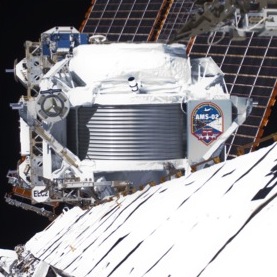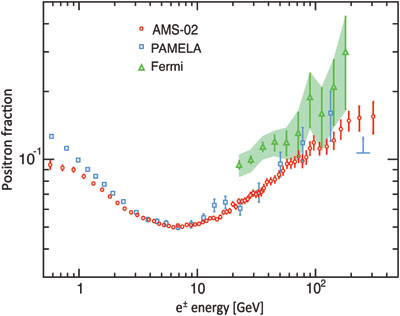.

PARTICLE CATCHER: The Alpha Magnetic Spectrometer collects high-energy particles on the orbiting International Space Station.
Image: AMS/NASA
.
Dark Matter Signal Possibly Registered on International Space Station
The onboard Alpha Magnetic Spectrometer has detected what is thought to be dark matter’s signature antimatter particles, but it cannot yet pin down their origin
.
A $2-billion particle detector mounted on the International Space Station has registered an excess of antimatter particles in space, the experiment’s lead scientist announced April 3. That excess could come from fast-spinning stellar remnants known as pulsars and other exotic, but visible sources within the Milky Way galaxy. Or the antiparticles might have originated from the long-sought dark matter, the hypothetical massive particles that constitute some 27 percent of the universe.
Dark matter makes its presence felt by its gravitational pull, but exactly what it is has remained a puzzle. Some popular explanations for dark matter’s identity suggest that when two dark-matter particles collide, they annihilate to produce antimatter electrons, or positrons. The Alpha Magnetic Spectrometer (AMS), delivered to the space station in 2011 during the penultimate space shuttle mission, was built to detect positrons and other high-energy particles streaming through space, in part to investigate the nature of dark matter. The detector has now collected some 25 billion cosmic-ray particles, including 6.8 million electrons and positrons. The fraction of positrons in the particle mix exceeds what would be naively expected in the absence of dark matter or other unaccounted sources, but the new data lack a distinctive feature predicted of dark matter annihilations.
Dark matter collisions would produce relatively more high- than moderate-energy positrons. But the rise in positrons with increasing energy would continue only up to a point. Beyond a certain energy level, the number of positrons would fall off steeply, AMS spokesperson and Nobel laureate Samuel Ting of the Massachusetts Institute of Technology explained in a seminar at CERN, the European laboratory for particle physics. “The positrons could also come from nearby pulsars, and in such a case the positrons will have a slow drop-off” at higher energies, Ting said. “So the way they drop off tells you everything.”
The AMS data indeed show an increasing share of positrons toward higher energies, but no drop-off, so the origin of the excess particles remains unclear. The European PAMELA mission and NASA’s Fermi spacecraft have found similar trends in recent years, but Ting called AMS the first experiment “to probe in detail the nature of this excess with high sensitivity and precision.” The research will appear in the April 5 issue of Physical Review Letters.
Ting only presented data on positrons with energies of about 350 giga-electron-volts or less but said that AMS will in the coming years catalogue particles up to 1,000 giga-electron volts. So the experiment may soon reveal or disprove the presence of a positron cutoff at higher energies, which would provide a clue to the source of the particles: a steep drop would point to dark matter, and a gradual decline would indicate pulsars are the originators of the positrons.
When pressed by colleagues at the CERN seminar to discuss any data AMS has already collected on higher-energy particles, Ting demurred. “We will publish things when we are absolutely sure,” he said, repeatedly sounding notes of caution and calling for patience. “I think that no one is foolish enough to repeat what we are doing,” he said of the experiment, which was some 18 years in the making. “So we want to make sure we are doing it correctly.”
Quelle: Scientific American
.

.
AMS experiment measures antimatter excess in space
03 Apr 2013
Geneva 3 April 2013. The international team running the Alpha Magnetic Spectrometer (AMS1) today announced the first results in its search for dark matter. The results, presented by AMS spokesperson Professor Samuel Ting in a seminar at CERN2, are to be published in the journal Physical Review Letters. They report the observation of an excess of positrons in the cosmic ray flux.
The AMS results are based on some 25 billion recorded events, including 400,000 positrons with energies between 0.5 GeV and 350 GeV, recorded over a year and a half. This represents the largest collection of antimatter particles recorded in space. The positron fraction increases from 10 GeV to 250 GeV, with the data showing the slope of the increase reducing by an order of magnitude over the range 20-250 GeV. The data also show no significant variation over time, or any preferred incoming direction. These results are consistent with the positrons originating from the annihilation of dark matter particles in space, but not yet sufficiently conclusive to rule out other explanations.
“As the most precise measurement of the cosmic ray positron flux to date, these results show clearly the power and capabilities of the AMS detector,” said AMS spokesperson, Samuel Ting. “Over the coming months, AMS will be able to tell us conclusively whether these positrons are a signal for dark matter, or whether they have some other origin.”
Cosmic rays are charged high-energy particles that permeate space. The AMS experiment, installed on the International Space Station, is designed to study them before they have a chance to interact with the Earth’s atmosphere. An excess of antimatter within the cosmic ray flux was first observed around two decades ago. The origin of the excess, however, remains unexplained. One possibility, predicted by a theory known as supersymmetry, is that positrons could be produced when two particles of dark matter collide and annihilate. Assuming an isotropic distribution of dark matter particles, these theories predict the observations made by AMS. However, the AMS measurement can not yet rule out the alternative explanation that the positrons originate from pulsars distributed around the galactic plane. Supersymmetry theories also predict a cut-off at higher energies above the mass range of dark matter particles, and this has not yet been observed. Over the coming years, AMS will further refine the measurement’s precision, and clarify the behaviour of the positron fraction at energies above 250 GeV.
“When you take a new precision instrument into a new regime, you tend to see many new results, and we hope this this will be the first of many,” said Ting. “AMS is the first experiment to measure to 1% accuracy in space. It is this level of precision that will allow us to tell whether our current positron observation has a Dark Matter or pulsar origin.”
Dark matter is one of the most important mysteries of physics today. Accounting for over a quarter of the universe’s mass-energy balance, it can be observed indirectly through its interaction with visible matter but has yet to be directly detected. Searches for dark matter are carried out in space-borne experiments such as AMS, as well as on the Earth at the Large Hadron Collider and a range of experiments installed in deep underground laboratories.
“The AMS result is a great example of the complementarity of experiments on Earth and in space,” said CERN Director General Rolf Heuer. “Working in tandem, I think we can be confident of a resolution to the dark matter enigma sometime in the next few years.”
Quelle: CERN
.
Update: 5.04.2013
.
AMS confirms positron excess
.
The international team running the $1.5bn Alpha Magnetic Spectrometer (AMS) has announced it has seen an excess of positrons at high energies that could point the way towards a possible detection of dark matter. Speaking at CERN yesterday, AMS principal investigator Samuel Ting presented the first results from the space-based observatory, adding that the positron excess may originate from dark matter or could be from a more benign source, such as pulsars.
The AMS sits on the International Space Station (ISS) and is designed to study high-energy particles – or cosmic rays – before they have a chance to interact with the Earth's atmosphere. Weighing 7.5 tonnes, the AMS detector uses a 0.15 T cylindrical magnet 1 m in diameter and 1 m in height to sort incoming particles according to their momentum and charge. The direction of bend of the particle tracks through the magnet's bore depends on whether the particles are matter or antimatter, while the gradient of the bend is determined by their speed. This allows the detector to distinguish between vast numbers of different types of cosmic-ray particles.
The AMS searches for an excess of charged particles such as positrons in an energy range from 500 MeV to 1 TeV. It studies the ratio of positrons to electrons – "the positron fraction" – over this entire range looking for any excess that could point to the evidence of dark-matter annihilation. This could be caused, for example, by the presence of WIMPs – leading candidates for dark matter – or other candidate particles that are colliding with each other and emitting the charged particles.
Excess events
In 2008 the Italian-led Payload for Antimatter Matter Exploration and Light-nuclei Astrophysics (PAMELA) mission gathered tentative evidence of an excess of positrons at energies of up to 100 GeV – positrons that could have been produced by the annihilation of dark-matter particles. According to standard theory, the positron fraction should fall off with increasing energy. The PAMELA results, however, were not watertight, mainly because of the possibility that the mission was confusing positrons with the far larger numbers of protons reaching its detectors.
Then in 2011 NASA's Fermi Gamma-Ray Space Telescope supported PAMELA's findings and confirmed a larger-than-expected rate of high-energy positrons reaching the Earth from outer space. Although Fermi is a gamma-ray telescope, the probe works by detecting electron–positron pairs and so is also well suited to studying cosmic rays.
Detecting antimatter
Presenting the results to a packed auditorium at CERN yesterday, Ting says that the AMS has so far collected around 18 months' worth of data – around 10% of the amount it expects to collect over its 20-year lifetime. The AMS has collected 25 billion events to date, of which 6.8 million were identified as electrons and positrons. Of these 6.8 million events, around 400,000 are positrons with energies between 0.5 GeV and 350 GeV – the largest number of antimatter particles directly measured and analysed from space.
The positron fraction as measured by the AMS shows a decrease from 1 to 10 GeV but then increases from 10 to 250 GeV. Ting, who works at the Massachusetts Institute of Technology, adds that the data also indicate no sharp peaks or significant variation over time, or any preferred incoming direction. Assuming an isotropic distribution of dark-matter particles, the results are consistent with positrons originating from the annihilation of WIMPs in space.
,

"The results show how precise our detector is in measuring very weak effects, like the behaviour of the positron ratio at high energy," AMS deputy spokesperson Roberto Battiston from the University of Trento in Italy told physicsworld.com. "Collecting more statistics at higher energy will likely shed light on the origin of the source of positron excess."
"It is quite impressive and the agreement with the earlier PAMELA results is excellent – a tribute to the hard work of the PAMELA team that had a much smaller instrument with a less intense magnetic field in a different orbit around the Earth," says astrophysicist John Wefel from Louisiana State University.
'Beautiful results'
However, the AMS measurements cannot yet rule out alternative explanations, such as the positrons originating from pulsars. Supersymmetry theories predict a cut-off at higher energies above the mass range of dark-matter particles, and this has not yet been observed.
"Astrophysics is very good at making positrons and the rise could be due to astrophysics we don't yet understand, rather than dark matter annihilations," says Michael Turner from the University of Chicago. Turner, who calls the AMS results "beautiful", adds that the WIMP hypothesis fits the data, "but as Carl Sagan taught, extraordinary claims require extraordinary evidence and we are not there yet".
Ting adds that over the next few years, the collaboration will further refine the measurement and attempt to clarify the behaviour of the positron fraction at energies above 250 GeV. Indeed, the positron fraction already indicates a levelling off above 250 GeV, hinting that a drop off could be in sight. "We have a feeling what is happening, but it is too early to discuss this," says Ting.
"As to the question uppermost in everyone's mind – do the measurements indicate dark matter? – unfortunately the answer is yes, no and maybe," adds Wefel. "Whether [the levelling off] is physics or statistics or instrumental cannot be determined without more data. We just have to stay tuned and be patient."
The rocky road to the ISS
Ting, who shared the 1976 Nobel Prize for Physics with Burton Richter for the discovery of the J/ψ particle, has built up a collaboration of some 600 physicists from 60 institutes in 16 countries who work on the AMS.
The AMS was first proposed by Ting in the 1990s after he failed to get support for a couple of ground-based particle experiments – a detector for the ultimately doomed Superconducting Super Collider and an upgrade of the L3 experiment at CERN near Geneva.
Ting's idea to put a detector in space was fortuitous, given that the then administrator of NASA, Dan Goldin, was keen to give the ISS some scientific credibility. In 1995, following a positive review of the AMS by the US Department of Energy, Ting secured a space-shuttle flight from Goldin and then set about obtaining funding from mainly European governments. The AMS team concluded that the detector was simply too heavy and too power hungry to be put into orbit on its own dedicated satellite.
However, the AMS was delayed following the Columbia Space Shuttle disaster in 2003, with NASA deciding that all subsequent space-shuttle flights should be devoted to completing the ISS. In 2008 Congress then approved legislation for an additional, dedicated flight to take the AMS to the ISS. The AMS was finally lifted into orbit on board the Space Shuttle Endeavour in May 2011.
Quelle: Physicsworld
6899 Views
